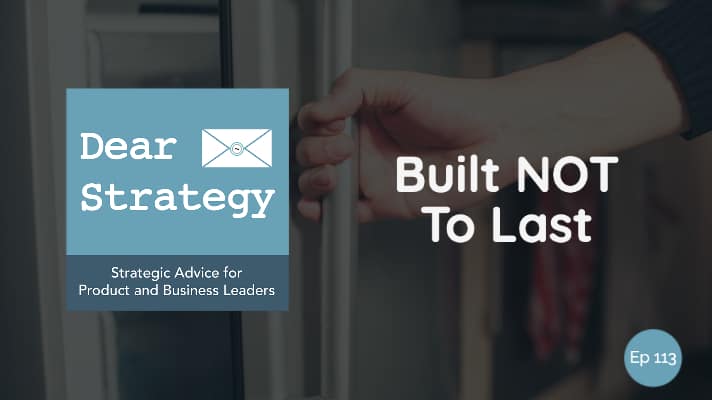On this episode of Dear Strategy, we analyze the story of a poorly designed refrigerator that lasted around 5 years before it finally bit the dust. And, of course, the warranty didn’t cover it. With more and more technologies being incorporated into just about every product we own, is this the new norm that we should be expecting from our previously long-life products?
Life seems to be getting more and more complex. When I was a young child, I really thought that someday technology would make all of our lives a whole lot easier. And although there is certainly no denying that some things have become more convenient, that convenience seems to have come at some cost. For example…
Devices work to make our lives safer and simpler at every turn. But when those devices don’t work together (which they often don’t), they actually become more of a burden than some of the problems they are supposed to be solving for us.
Gadgets come with an excess of features that allow us to do and know all sorts of things that we once only could have dreamed of. But with all those extra features come a whole lot of extra instructions to understand, and a whole lot of extra components to maintain; both of which tend to suck away all the time that those features were supposed to have saved us in the first place.
Information spreads around the world at light speed, which can be an incredible asset. But if you put something out there that hasn’t been thoroughly thought through, there’s no way to put that genie back into the bottle. That means we all have exactly one chance to get everything right, which, for most of us humans, simply isn’t enough.
These are just a few examples of how technology has made our lives a little bit worse in the process of trying to make it a little bit better. And it can all be very scary at times. But the real question is, what in the world does any of this have to do with my refrigerator?!
Well, here’s the short story:
I got a refrigerator that came with a lot of extra features that I really didn’t need. And those features required extra wires. And those extra wires broke long before I would have expected the refrigerator itself to break. And, of course, the warranty that would otherwise have covered those wires had long since expired (which is actually a story for a different day). So, in summary, I had a product with a lot of extra features that I didn’t need, that lived a shorter life than I would have expected, but that lived a longer life than the company was willing to back.
At least in my mind, what this story represents is a trend of companies building relatively short-life features into otherwise long-life products.
Appliances, cars, cameras, audio equipment… these are all examples of products that, 40 years ago, we would have expected to last 10, 20, even 30 years or more. But today, these same products are all being built with an excess of bells, whistles, and extra added features that all serve as, at best, points of expedited obsolescence, and, at worst, points of premature product failure.
The problem here isn’t the fact that features are being added, it’s the fact that, as consumers, we are still conditioned to believe that these products will last far longer than they actually do. So we pay a premium thinking we’re getting long-life products, and then inevitably become frustrated and annoyed when we realize that our original expectations were off by a factor of, in some cases, many years.
“The problem isn’t the fact that features are being added, it’s the fact that, as consumers, we are still conditioned to believe that these products will last far longer than they actually do.”
Another good example of this is my car. Back in 2017, I bought a brand-new SUV. It isn’t, by any means, the most expensive SUV on the market. But, even so, almost every aspect of the car is run by computer. Which means that even the most basic manual functions – like unlocking the door, shifting the transmission, and even turning the car on and off – have all been replaced with “more convenient” digital controls and sensors. Convenient, that is, until those controls start to fail – which, by the way, every single one of these did in my particular case! And all of that happened within the first 3 years!
So, I paid a premium for a car that I expected to last without any major issues for at least the first 10 years or so, and I ended up having issues – some of which left the car inoperable – all within the first few years of ownership. And all because of features that I didn’t want, I didn’t need, and I didn’t ask for.
Maybe it’s just me, but something just doesn’t feel right here.
You may have heard of the term “planned obsolescence,” which, in a nutshell, is the practice of building a product that is designed to become obsolete after a certain period of time. A good example of this is a product that has a non-replaceable battery. Or computer components that will eventually be rendered incompatible with operating systems of the future. These, by the way, aren’t inherently bad practices. Instead, they are understood, expected, and usually priced accordingly. So that’s not exactly what I’m talking about here.
Instead, what I’m referring to is when companies sneak short-life features into products that should otherwise have much longer life spans without giving us, as consumers, much choice in the matter. Like my 5-year old “digital” washing machine that now stops halfway through almost every washing cycle due to a “load imbalance” error when clearly no such imbalance exists. Shame on me for not realizing that a digital washing machine couldn’t possibly last as long as a fully mechanical one. Still, that is, in fact, the trap that we consumers fall into just about every day.
But, as with all of our strategy stories, the point is not just to complain (well, at least not officially). Instead, the point is to ask the basic question, “Is this a good strategy?” So let’s get into that a bit…
I suppose you can argue that anytime a company can get maximum dollar for a relatively short-lived product, that’s probably not a bad financial strategy. However, you can also argue that the long-term impact of such a strategy can be very damaging to a company’s overall brand, especially if consumers had a different expectation in mind.
In my particular case, I can’t say exactly why the wires in my refrigerator broke when they did, but I can harbor a guess that the company was over-focused on building a “higher-tech” appliance, and not focused enough on making sure that all the systems that supported those technologies would last as long as the refrigerator itself. That, coupled with a warranty that drove no real accountability after the first year or two of operation, was a recipe for letting me down as a customer. And that’s exactly what ended up happening. Same for my car; same for my washing machine; and the list goes on and on…
The point is, I really feel that companies need to think carefully through the strategy of building shorter-life technologies into otherwise long-life products. I suppose if they keep doing it, then our collective expectations of how long those products are supposed to last will eventually match how long they actually do last. And I imagine the prices that we’re ultimately willing to pay for those products will eventually start to match our reduced expectations accordingly. But maybe there’s a better way…
Perhaps companies can start incorporating modular technologies into their products so that we can easily replace the shorter-life portion of a product without having to pay to replace the main product itself. Or maybe companies can offer different warranties for different parts of their products – maybe a year on the actual technology portion, but many more years on everything else. (Some companies do this today, by the way, but not comprehensively enough to cover the parts you actually need to be covered!) Or maybe companies can start offering base model products without all the bells and whistles but with all the same high-quality parts and components that the higher-end versions currently utilize. Or maybe companies can just start paying more attention to their customers’ true expectations and then start matching their products to what those expectations really are.
Any of these, in my opinion, are better strategic options than building products that are almost certain NOT to last as long as customers expect them to. Sure, all those high-tech features may seem like clever points of differentiation in the short-term. But when that differentiation starts to fail, companies need to start asking themselves if it was really worth it.
If you ask me, I’m not sure that it was.
Listen to the podcast episode
Dear Strategy: Episode 113

Are you interested in strategy workshops for your product managers or business leaders? If so, please be sure to visit Strategy Generation Company by clicking the link below:
 Bob Caporale is the founder of Strategy Generation Company, the author of Creative Strategy Generation and the host of the Dear Strategy podcast. You can learn more about his work by visiting bobcaporale.com.
Bob Caporale is the founder of Strategy Generation Company, the author of Creative Strategy Generation and the host of the Dear Strategy podcast. You can learn more about his work by visiting bobcaporale.com.







